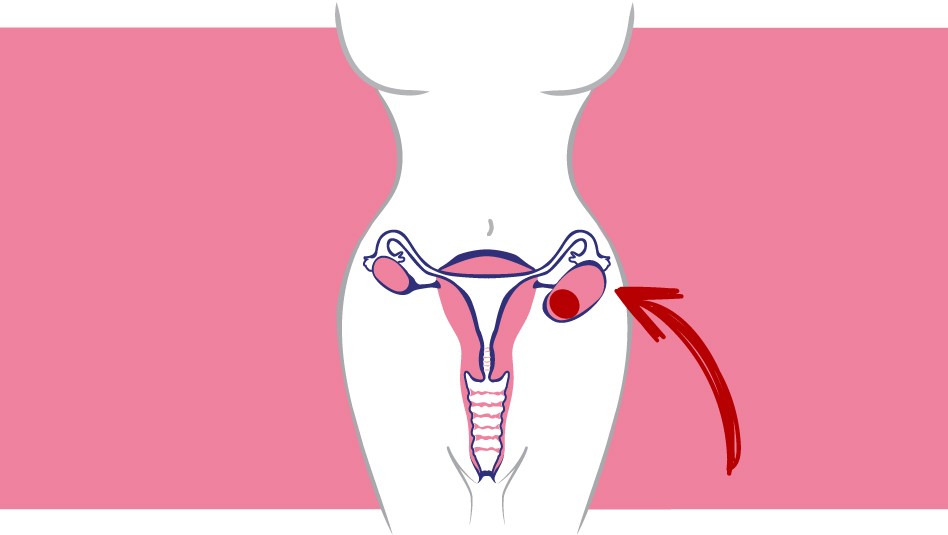Ovarian Cysts
What are ovarian cysts?
Ovarian cysts are sacs or “bubbles” full of fluid that are found on the surface or within both ovaries. During the reproductive years of a woman, the ovaries produce, develop and release a mature egg or ovum every month.
A high percentage of women suffer from ovarian cysts at some time during their lives. Most such cysts cause little or no discomfort but only a slight indisposition. They may even disappear spontaneously after a few months without treatment. Others may present symptoms or even considerable pain that can only be remedied by urgent surgical treatment, especially in the case of twisting or rupture of the cyst capsule.
Almost all ovarian cysts are benign, although clinically speaking they are indistinguishable from malignant ovarian tumours. Differential diagnosis can be difficult, and appropriate and early diagnosis of any cyst is important to prevent the possibility of ovarian cancer. A good knowledge of the symptoms and of the different types of cysts is advisable, as well as regular gynecological check-ups.
What are the symptoms of ovarian cysts?
Most cysts present no symptoms. However, should they appear, they may be of the following different types:
Menstrual irregularity
Persistent pain in the abdomen or pelvis, which may also be felt in the back or legs.
Pelvic pain throughout menstruation as well as at the onset
Pain during coitus (dyspareunia)
Nausea, vomiting or hightened sensitivity in the breasts
Feeling of heaviness, abdominal distension
Pressure on the rectum or bladder accompanied by difficulty in emptying the bladder.
In the following cases, it is very important to see a doctor immediately or go to A & E:
Sharp, sudden or intense pain in the pelvis or abdomen
Pain accompanied by high temperature or vomiting
What types of ovarian cysts are there?
The ovaries normally increase in size every month and produce cysts known as follicles, which produce hormones (oestrogen and progesterone). The ovary releases an ovum during ovulation, while the follicular cyst continues to grow. When this occurs, it is known as a functional cyst, and this is a normal process within the menstrual cycle.The following types are distinguished:
Follicular cyst: when the follicle does not break open, but continues to grow and becomes a cyst full of transparent fluid. This type of cyst rarely causes pain and disappears spontaneously over two or three menstrual cycles.
Corpus luteum cyst: the opening through which the ovum emerges sometimes closes and fluid accumulates inside the follicle. Normally, this disappears after a few weeks, but it may grow and either cause bleeding within or twisting of the ovary, which in turn leads to pain in the pelvis or abdomen. If it fills with blood, the cyst may burst, causing haemorrhage and acute pain.
There are other type of cysts:
Serous cystadenoma: smooth surface, thin wall cyst containing fluid. Can be quite large – from 5cm to 20cm – and liable to cause twisting of the ovary.
Mucinous cystadenoma: ovarian tumours of greater size, sometimes affecting both ovaries. They are round or oval-shaped translucent tumours of a blush-grey colour containing a thick fluid.
Endometriomas: contain a thick, chocolate-coloured fluid.
Dermoid cysts or teratomas: mainly benign due to their embryonic origin. Contain sebaceous material together with hair, cartilage, bone and teeth. They appear during the first three decades of life and may grow until causing torsion or pain.
Solid tumours: the least frequent, the best known type being the ovarian fibroid, which is sometimes associated with accumulation of fluid in the pleura (membrane investing the lungs) and the peritoneum (membrane investing the intestines).
When should I see a doctor?
Whenever you feel abdominal distension or severe pain in the lower abdomen. Other signs that require immediate attention are: a sensation of coldness, sweating, accelerated breathing, a feeling of dizziness or weakness. It is important to have regular gynecological check-ups in order to detect the possible presence of cysts that present no symptoms.
How are ovarian cysts diagnosed?
Diagnosis is performed with an examination of the pelvis by palpating the ovaries. In the suspected presence of a cyst, the examination is completed with other tests to determine its type and to assess the treatment required. Characteristics such as the shape, size and content (liquid, solid or mixed) of the cyst will be taken into account.
Diagnosis can be confirmed according to different variables:
Rule out pregnancy: pregnancy suggests a corpus luteum cyst, which is normal during gestation.
Transvaginal pelvic ultrasound: a painless test to provide an image of the uterus and ovaries in order to identify the location of the cyst and to determine whether its content is solid, liquid or mixed.
CA 12-5 blood test: performed in patients with ovarian cancer or any image suspicious of malignancy.
Magnetic resonance in cases where malignity is suspected or those with diagnostic uncertainty.
Laparoscopy: it is the recommended treatment.
What is the treatment of ovarian cysts?
This will depend on the age, size and characteristics of the cyst and its symptoms. If the cyst is of the follicular or functional type, it may disappear by itself. If it produces no symptoms, regular ecographic tests are performed until it disappears. Should it persist, surgical treatment is advisable.
Laparoscopy is recommended as treatment and exeresis of cysts that are either not functional or continue to grow, as well as cysts that cause pain or present other symptoms, always providing that they are benign.
It is important to take great care with the ovaries and preserve them wherever possible. Should extraction of an affected ovary be necessary, the other ovary will be left intact without affecting fertility. If the cyst is malign, a further surgical operation will be performed.
The risk of ovarian cancer increases in post-menopausal patients, and therefore in these cases surgery is recommended whenever a new cyst is found in the ovary.
Can ovarian cysts be prevented?
Although there is no definitive method of prevention, regular check-ups are essential for early diagnosis of any change occurring in the ovaries.

